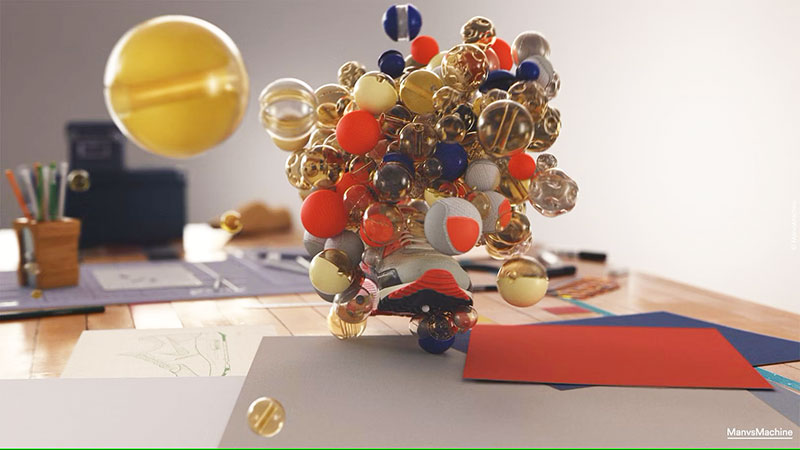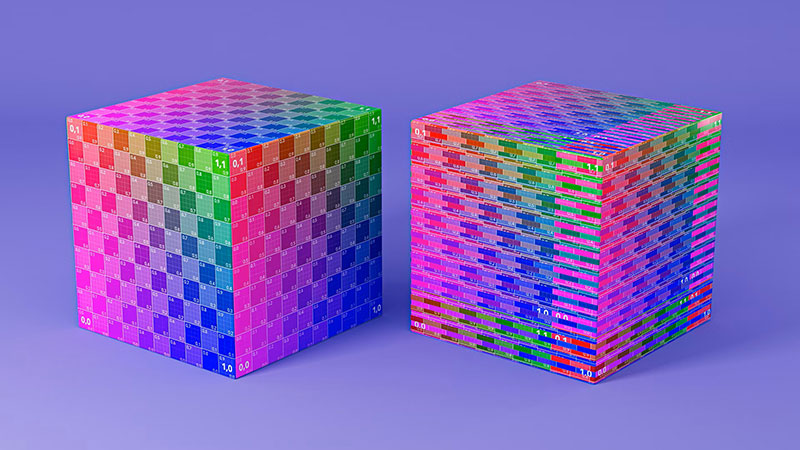Cinema 4D’s MoGraph tools and Redshift’s RT real-time camera and shading get a performance push. Redshift can also tap into Apple M3 chips’ new hardware-accelerated ray tracing.

Maxon’s October release updates several of the Maxon One applications – Cinema 4D, Redshift, Magic Bullet and Cineware.
New Cinema 4D users now have ready to render starter scenes to help them learn more quickly how the tools work, and MoGraph users will see speed gains when working with Effectors and Multi-instance Cloners.
The new undersampling for RT in Redshift enhances performance when moving the camera through a scene. Also, new sets of Capsules have been added to give artists more opportunities to use specialised professional materials for their scenes.
Cinema 4D – Working Faster
Continuing the performance improvements introduced in September for Cinema 4D 2024.1, this most recent update results in speed enhancements for MoGraph tools that particularly focus on Effectors and Multi-instance Cloners.
Instances are groups of clones, or copies, of objects that can be instantly modified, simply by modifying the original object. As the computer does not have to modify all the objects one by one, this feature makes changing a set of equal objects much faster.

Effectors are the various methods of animating the objects and clones – moving, rotating and scaling but also randomising, shading – or, animating based on texture – and others.
A collection of stylised, preconfigured scenes are available and ready to render, designed to serve as a starting point for new Cinema 4D users as they launch into creative projects. When Cinema 4D is opened as a trial, a starter scene will be open as well, which artists can reverse engineer or work with however they want, to help learn how the tools are used. No specific tutorials are available yet, but plans for tutorials and other, more varied types of starter scenes are underway.
Redshift – Real-time Camera and Textures, Distortion
The Redshift 3.5.20 update affects all supported content creation applications, enhancing the image quality and camera navigation speed when moving through a scene in Redshift RT, and improving pixel-based displacement mapping performance and quality.
Using Redshift RT to move your camera through a scene no longer turns render previews into low-res, noisy images. RT is Redshift’s real-time rendering feature used for Interactive Preview Rendering in the viewport. With the new undersampling technique for RT, the camera navigation speed can be increased while the view is set to maintain a specified level of quality.

Distorter node
When working with high-density meshes and generating close-up renders, per-pixel displacement in RT shows better performance when compared to earlier versions of Redshift. Displacement mapping is controlled by a texture, and physically displaces tessellated geometry. Because it actually perturbs the surface geometry, unlike a bump map, it affects shadows and needs good performance.
Further to textures, RT also now supports texture compression, which reduces the amount of VRAM that the textures take up. The Distorter shader in Redshift now supports 3D distortions using the Maxon Noise shader, meaning that Distortion is no longer limited to colour texture inputs. 3D distortion of the Maxon Noise node and distortion of bump maps is now possible.
Cinema 4D’s Distorter node is now part of Redshift in Cinema 4D. The Distorter shader can be used to drive distortion of the UV space for a material according to texture or shader input, immediately producing variation to break up repeating maps.
The MatCap shader, which creates stylized, non-photo-real materials by mapping an image onto a mesh, now has new parameters. This shader allows artists to prepare attractive, illustrative renders from their own digital sketches.

MatCap shader
Updates to Redshift and Cinebench 2024 take advantage of the new developments in Apple’s M3-series chips. Apple’s new GPU architecture features hardware-accelerated ray tracing, resulting in speed increases when rendering photorealistic imagery with Redshift. Maxon’s Cinebench 2024 benchmarking tool, built on Redshift and Cinema 4D and available as a free download, can be used to evaluate the performance of the new chips.
Magic Bullet Fixes
This update to Magic Bullet 2024.1 includes hotfixes that individually address multiple bugs for a smooth, consistent experience. An issue with the Red Giant analytics library, which logged session data inaccurately, was corrected. A bug causing tool strength to reset when moving tools within the Toolchain was fixed, with others for localization that affected saving presets in the Colorista workflow.
Cineware
The updated Cineware for Adobe Illustrator plugin establishes compatibility between the latest releases of Adobe Illustrator 2023 and Cinema 4D 2024.1. This update allows users to add and edit 3D objects directly within Adobe Illustrator. Cineware is Maxon’s file exchange and render connection library.

Cineware for Adobe Illustrator
Capsules – Plants, Stone, Splines
The new capsules in this release include 54 new plants from Laubwerk, 26 Redshift stone wall materials by Fuchs & Vogel and over 30 example projects. The detailed, hyper-realistic plants and stone materials are made to contribute realism and beauty to scenes for architectural visualisations, and gaming environments or cinematics.
A new Pulse Spline Modifier by Rocket Lasso has also been added to simplify the animation of spline growth and revealing. For instance, it can be integrated directly with the Electric Spline Modifier, which is used to calculate flashes, to generate dynamic surges of energy.
When applied to a Text Spline, it produces text write-on effects. It also supports splines with weight maps driven by fields (or areas), which means you can erase and reveal sections within intricate splines to produce motion graphics effects. www.maxon.net


